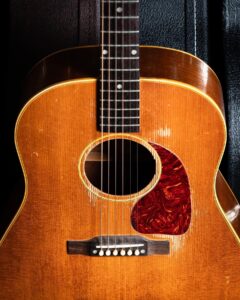Vintage Guitar has become a multi-million dollar industry with specialist dealers and stores worldwide. Many buyers will only buy a genuine vintage guitar with a certificate of authenticity.
Many people treat vintage guitars like religious artefacts or priceless relics. However, they’re still just pieces of wood and wire.
Age
 Among guitar enthusiasts, there is an idea that a vintage instrument will sound better than a newer one. This is mainly due to natural aging, which causes the wood to change over time. This process can also happen if the Guitar is played for many hours and can affect how the strings vibrate on the instrument. This can help the Guitar reach a more harmonious balance. Another factor is the type of finish the Guitar has, which may influence how it sounds over time. Guitars with nitrocellulose finishes are thought to age better than those with polyurethane.
Among guitar enthusiasts, there is an idea that a vintage instrument will sound better than a newer one. This is mainly due to natural aging, which causes the wood to change over time. This process can also happen if the Guitar is played for many hours and can affect how the strings vibrate on the instrument. This can help the Guitar reach a more harmonious balance. Another factor is the type of finish the Guitar has, which may influence how it sounds over time. Guitars with nitrocellulose finishes are thought to age better than those with polyurethane.
In addition to these factors, the age of a vintage guitar may impact its value. This is because particular decades, and even specific guitar models, have become associated with certain sounds. For example, many consider Jimi Hendrix’s Fender Strat a “holy grail” guitar. This is because it was a model from a limited run of instruments and has become associated with the legendary guitarist.
This idea of special magic associated with a vintage guitar is often called mojo, and it is a popular topic for discussion in music circles. Many people believe a guitar will have more mojo than a newer one, which can influence the price. Whether this is true is a matter of opinion and depends on what kind of mojo a person is looking for.
Some people buy vintage guitars for their beauty and the fact that they are old. Others do it because they are interested in the legacy of the Guitar and want to own a piece of history. Regardless of the reason, it is essential to do your research before buying a vintage guitar. Not all older guitars will sound different, and not all will be worth the money.
The best way to determine if a guitar is genuinely vintage is to look at the serial number. A lower serial number is generally more valuable, indicating how long the Guitar has been in production. However, some manufacturers have used the same serial numbers for multiple types of guitars over the years, so it’s not always possible to determine the exact age of a guitar.
Condition
A vintage guitar’s condition is a significant factor in its value. A mint-condition instrument with all original parts will command a higher price than an identical one with some repairs or replacements. Those repairs and replacements could be as minor as replacing an old pickup with a newer model or as significant as a neck repair (especially on mahogany-bodied Gibsons) that affects the instrument’s structural integrity.
An excellent way to evaluate a guitar’s condition is to compare it with similar models in the same year of manufacture. Suppose you have a Guild Starfire that is in pristine condition and has the custom Harvey Leach inlays. It will likely be worth more than a similarly sized Epiphone Casino from the same period (no relation to the company).
If a guitar has been refinished at any time, it will drop its value considerably. Typically, even painting over a crack to cover up a repair decreases the value of the Guitar by 50% or more. Refinishing is a common issue that must be addressed to appraise a guitar’s condition properly.
Another essential factor to consider is if the Guitar has been modified by its previous owner or has any non-original replacement parts. While many guitarists enjoy upgrading their instruments with new pickups, switches, and other accessories, that will also decrease the Guitar’s value, especially for collectors.
A vintage guitar must also be free of any damage or deterioration due to a lack of quality control during production or cost-saving measures from the factory. Look carefully at the edges and joins of the body to see if there are signs of binding wear, loose critical, or any other character that the Guitar was not made to the highest standard. Also, check the nut, bridge, and tuning machine heads to ensure they are original. These areas of the Guitar are most prone to damage and can be the most precise indicators of lower quality. Even these details can significantly impact the value of an instrument, so it is best to let a professional inspect and appraise a vintage guitar before making any purchase decisions.
Design
Many people like to own vintage guitars for several reasons. Some people think that old instruments sound better than new ones, or they may prefer the aesthetics of a vintage tool. Others, however, believe that vintage instruments have some sort of mojo that makes them unique. This concept is difficult to define, but it is a common belief among people who collect vintage guitars.